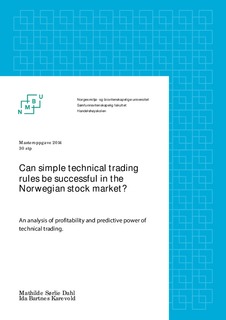Can simple technical trading rules be successful in the Norwegian stock market?
Master thesis
Permanent lenke
http://hdl.handle.net/11250/217361Utgivelsesdato
2014-08-15Metadata
Vis full innførselSamlinger
- Master's theses (HH) [1072]
Sammendrag
In this analysis, two simple technical trading rules, moving average and trading-range breakout, are tested by utilizing OBX and OSESX from Oslo Stock Exchange in 1997-2013. To assess if the rules are successful, the performance is tested with a traditional t-test and a residual bootstrap by Brock, Lakonishok and LeBaron (1992). To correct for possible data snooping bias, White’s (2000) Reality Check is applied. The t-test signals that the trading rules are profitable on OSESX, and that buy signals consistently generate higher returns than sell signals. Further, the returns following buy signals are less volatile than returns following sell signals. The returns following sell signals are negative, which is not consistent with existing equilibrium models. The profits are not eliminated by transaction costs, but the performance is not robust across subperiods. The results are significant after correcting for data snooping. The residual bootstrap shows that returns from the trading rules are not consistent with a random walk, but suggests time-varying expected returns as an explanation. The volatility following buy and sell signals is not as easily explained by time-varying volatility. This indicates that the profitability is not due to predictive power of the rules, but that the rules may be able to detect periods with lower volatility. Overall, the results provide low support for technical analysis in the Norwegian stock market.
Beskrivelse
An anlysis of profitability and predicitive power.
